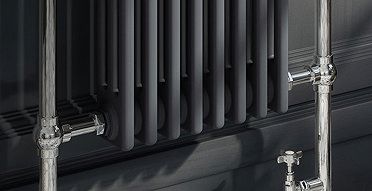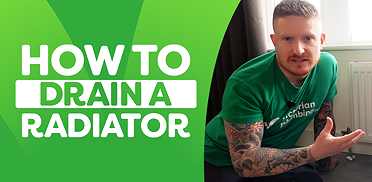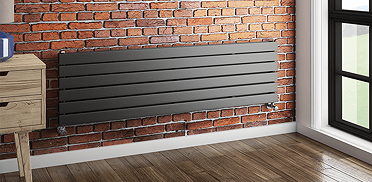OUR WINTER SALE ENDS SOON!
*Boxing Day deals coming soon. Free delivery on orders over £499
Which Radiator Valves Should I Buy?
Which Radiator Valves Should I Buy?
Choosing the wrong radiator valve wastes heat, drives up bills, and can even break Building Regs. Here’s the cheat sheet that saves energy, money—and your shins.

TL;DR
Two decisions, done
- Control – Manual tap | Thermostatic (TRV) | Smart TRV
- Geometry – Straight | Angled | Corner | H-block
- Pipe from the floor → Angled
- Pipe from the wall → Straight (Corner for a cleaner look)
- One radiator must stay manual for boiler bypass (Part L)
- Swapping manuals for TRVs can cut annual heating bills 10 – 20% (average 17%)
- Full checklist and FAQs at the end—no valve left behind
Radiator valve basics in 60 seconds
Radiator valves control the flow of hot water into (and out of) each radiator, letting you isolate or regulate heat room-by-room.
A radiator has an entry and an exit for water, so it needs a valve on each side:

Rule of thumb: One user-adjustable control valve per radiator, one lockshield on the opposite side. Touch the control valve whenever you want heat; leave the lockshield alone after the system is balanced.
Recap: Radiator valves control the flow of hot water into and out of each panel or towel rail. In simple systems you get manual valves (you open/close them) or thermostatic radiator valves – TRVs that auto-adjust flow to hold a set room temperature. Valve shape is separate: straight runs inline, angled bends 90 ° for pipes rising from the floor, corner keeps the head flush, and H-block joins twin ports on centre-bottom designer rads.

Now you know the basics, here’s how to pick the perfect valve in just three quick checks
How to choose the right radiator valve in 3 steps
1. Inspect the pipe route – Does the feed rise from the floor, poke out of the wall, or track along it?
2. Locate the radiator ports – Side, underside/bottom, rear entry, or centre-bottom twin?
3. Match valve shape to pipe + inlet, then pick control type and finish.
Manual vs TRV vs Smart radiator valves

Modern TRVs are bi-directional but still fit on the flow side when possible to avoid water-hammer chatter.
Royal-flush rule: one radiator in the system must not have a TRV so the boiler always has a circulation path.
Radiator Valve Shapes and When They’re Non-Negotiable

*You can twist an angled valve 90 °, but the head sticks out – corner valves avoid bruised shins and look cleaner.
- H-block valves join two closely-spaced ports, keeping designer rads tight to the wall.
- Angled – 90° bend from floor pipe to side inlet
- Straight – inline from wall pipe to radiator
- Corner – same bend as angled but keeps head vertical, flush with wall
- H-block – compact twin connection for centre-bottom designer radiators
Quick-pick table (room × pipework)

Angle mantra:
- Pipe from floor → Angled
- Pipe from wall → Straight (Corner if you value shins)
Next up: make sure the valve you’ve chosen actually fits your pipes. Here’s how to tell if you need a 15 mm, 22 mm, or something rarer.
Common UK pipe diameters

Adapters and reducers exist for any mismatch.
Speaking of mismatches…the quickest way to ruin a designer radiator is a valve in the wrong finish. Let’s make sure yours looks as good as it fits.
Finish matchmaking

“Devil’s in the detail” – the wrong shiny blob can ruin a designer rad; the right brushed-nickel valve can make it pop.
Finish sorted? Before you touch a spanner, run through these five can’t-skip rules. Break one and your perfect valve can still underperform (or bruise your shins).
Five key don’ts
- TRV and wall thermostat in the same room = sensor civil war
- Don’t fit TRVs to every radiator—leave one manual bypass or you’ll starve the boiler.
- Don’t twist an angled valve sideways—shin-bruising guaranteed
- Flush micro-bore sludge before refit
- Don’t skip balancing; even a £1 k designer rad under-performs if lockshields are wide open.
Ready for some real-world pairings? Here’s how the rules above play out on actual radiators and pipe runs.
Orientation & practical examples

See how each example nails shape and aesthetics? Seal the deal by balancing the system and ticking the UK regs boxes below.
Balancing, ΔT50 °C, and UK regulations
Balancing – open lockshields on distant rads, throttle nearer ones so every room reaches temperature together.
ΔT₅₀ °C – UK rads are rated at a 50 °C flow-return difference; fit flow to the high side (top), return to the low side opposite to hit rated output.
Building Regulations Part L – one wall thermostat plus TRVs on all other practical radiators; leave one manual bypass. Exceptions: many bathrooms, kitchens or unheated halls.
Part J – radiator valves must not obstruct boiler ventilation or flue-service clearances. Never block an air-brick with a rad cover.
Shape × Pipe × Inlet fast-pick chart
All the theory in one place: pin this cheat-sheet in the van or toolbox for instant reference.
IF PIPE comes from FLOOR:
IF INLET on SIDE → ANGLED
IF INLET UNDER rad → STRAIGHT
IF PIPE comes from WALL:
IF want flush head → CORNER
ELSE → ANGLED turned sideways
IF PIPE along WALL into SIDE port → STRAIGHT
IF MIDDLE-connection rad → H-BLOCK (straight or angled)
Covers 99 % of installs.
Frequently Asked Questions About Radiator Valves
What happens if I put a TRV on every radiator?
Your boiler might short-cycle or fail to heat properly. UK Building Regs (Part L) require one radiator with a manual valve as a permanent bypass. Without it, pressure builds up when all TRVs shut off, potentially damaging the system.
Do angled and corner valves do the same job?
Yes and no. Both turn 90°, but corner valves keep the head flush and vertical, perfect when pipes come from the wall. Angled valves can be twisted sideways, but they stick out awkwardly—bad for aesthetics (and shins).
Why does my TRV bang or chatter when the heating turns on?
That’s usually a reverse flow issue—water’s coming in the wrong direction. While modern TRVs are bi-directional, installing them on the flow side (hot side in) is still best practice to avoid valve noise.
Can smart TRVs control heating without a central thermostat?
Not fully. Smart TRVs control zones, but you’ll still need a central boiler controller or wall stat to turn the boiler on/off. Think of TRVs as local dials—the main stat still runs the show.
Is there a difference between flow and return pipes?
Yes—flow carries hot water in, return takes cooler water out. Fitting TRVs on the flow side helps prevent hammering and ensures accurate room temperature control. Some systems mark these, but not always—test carefully.
How do I tell if my radiator valve is manual or thermostatic?
Try this: if it has temperature numbers (1–5) or clicks into place when rotated, it’s a TRV. If it spins freely with no markings and no change in flow sound, it’s a manual valve.
Buying checklist
- Measure pipe diameter – 15, 22, 10 or 8 mm.
- Note pipe route – floor / wall / along wall.
- Check radiator inlets – side, bottom, middle, rear.
- Pick valve shape – Straight / Angled / Corner / H-block.
- Pick control type – Manual / TRV / Smart TRV.
- Confirm one non-TRV radiator for bypass.
- Choose finish – match radiator or create contrast.
- Balance system after filling – adjust lockshields.
- Label TRV heads with preferred numbers.
- Annual service – exercise TRV pins; verify lockshields untouched.
Ready to go from feeling drained to flush with excitement?
Choosing the right radiator valve boils down to two picks – the geometry that fits your pipework and the control that fits your lifestyle. TRVs (or smart heads) in lived-in rooms can trim bills by a fifth, while manual valves belong on towel rails and the mandatory bypass rad. Match the finish, balance the system, and your heating will run quieter, cheaper, and bruise-free.
- Browse our full valve range — every size, shape, and finish you’ll ever need
- Check out our Bathroom DIY Tips & Advice blogs — step-by-step how-tos that save time and money
- Get inspired with our Bathroom Design Inspiration blogs— Home makeover & mood board inspo galore
- Read our Bathroom Buying Guides — clear, no-jargon advice before you splash the cash
- Save or share this guide — your DIY mates will thank you
- Dive into more heating hacks — because a warm home shouldn’t cost the earth (or your toes)

Jack
Jack is part of the resident bathroom bloggers team here at Victorian Plumbing. As a bathroom décor and DIY expert, he loves writing in depth articles and buying guides and is renowned for his expert 'how to' tutorials.


